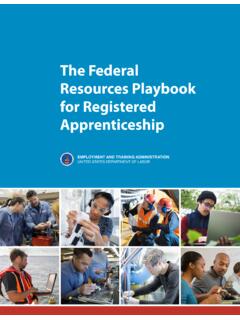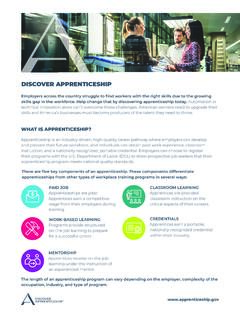Transcription of HIGH SCHOOL APPRENTICESHIPS
1 HIGH SCHOOL APPRENTICESHIPS : A GUIDE FOR STARTING SUCCESSFUL PROGRAMS How can communities better prepare high SCHOOL students for success and also ensure that businesses have the pipeline of skilled workers they need to thrive? Cities and states across the country are facing this dual challenge and a growing number are looking to high SCHOOL APPRENTICESHIPS as a solution. High SCHOOL (HS) apprenticeship programs combine work-based, on-the-job learning with relevant technical education in the classroom. Students who participate in these programs graduate with a high SCHOOL diploma, earn college credits, and industry credentials. They also start on a career path that continues after high SCHOOL graduation whether that is a continuation of their apprenticeship along with college, college only, apprenticeship only, or other full-time employment. HS APPRENTICESHIPS benefit businesses as well by providing a fresh source of talent developed from within their community. This guide is a resource for high schools, colleges, businesses, community organizations, and others seeking to collaborate on high-quality HS APPRENTICESHIPS in their communities.
2 It covers the basics of building a HS apprenticeship program and includes examples of program strategies. Additional resources on high SCHOOL apprenticeship are available at ELEMENTS OF A SUCCESSFUL HIGH SCHOOL APPRENTICESHIP The guide is organized around four key elements necessary to make high SCHOOL apprenticeship programs successful: 1. BUILDING STRONG PARTNERSHIPS. Strong partnerships among high schools and colleges, businesses, students and parents, and other community organizations are vital to successful HS APPRENTICESHIPS . Each partner has a key role to play and each supplies resources needed for high-quality programs. 2. ALIGNING PROGRAMS TO INDUSTRY WORKFORCE NEEDS. Successful HS APPRENTICESHIPS are business-driven, and the programs must be aligned to the skill needs of businesses to be effective in helping businesses build a pipeline of future workers. 3. DESIGNING QUALITY PROGRAMS. HS APPRENTICESHIPS can be created in multiple ways that work for businesses, SCHOOL systems, and students, but all are based on high-quality on-the job learning combined with related classroom instruction.
3 Successful programs also align coursework with both high SCHOOL and college requirements so that students receive all educational credentials possible, and can continue their education. 4. PROMOTING STUDENT SUCCESS. Successful programs engage in thorough recruitment and selection processes, and provide students with the support they need to complete the apprenticeship and take the next steps to succeed in college and careers. BUILDING STRONG PARTNERSHIPS PROMOTING STUDENT SUCCESS ALIGNING PROGRAMS TO INDUSTRY WORKFORCE NEEDS DESIGNING QUALITY PROGRAMS 2 WHY ARE HIGH SCHOOL APPRENTICESHIP PROGRAMS IMPORTANT? High SCHOOL is a critical time for development of career choices, and communities across the country are launching programs allowing high SCHOOL students to pursue career -oriented coursework coupled with work-based learning opportunities. These programs have different names, high SCHOOL apprenticeship, SCHOOL -to-apprenticeship, or youth apprenticeship, but all have the same goals providing students with access to high-quality, industry-focused training that combines classroom and on-the-job learning, and affordable pathways to college and careers in high-demand industries.
4 HS apprenticeship programs also provide businesses with solutions to their workforce needs. By training and mentoring young apprentices, businesses can develop employees who are trained to their precise specifications and have learned the company s unique workplace culture. HS apprenticeship programs also provide a source of qualified workers, reducing recruitment costs and ensuring businesses have the workforce they need today and for the future. Additionally, HS apprenticeship programs are frequently linked to adult APPRENTICESHIPS , referring to APPRENTICESHIPS after high SCHOOL in which businesses hire individuals (18 years of age and older) as full-time employees. Through effective partnerships, entry into adult APPRENTICESHIPS can be facilitated through the HS programs. HS APPRENTICESHIPS are also valuable for SCHOOL systems, as applied learning and hands-on experience may enhance SCHOOL retention and graduation rates. These programs also create stronger linkages between high SCHOOL and two- and four-year colleges, which often provide leadership, technical instruction, and support to programs.
5 Building on college credits earned in high SCHOOL , participating students are motivated to continue their education after graduation. WHAT ARE THE BASIC COMPONENTS OF HIGH SCHOOL APPRENTICESHIP? HS APPRENTICESHIPS provide the foundation for students to choose among multiple pathways after high SCHOOL , including enrolling in college, entering an adult apprenticeship program, beginning full-time work, or a combination of these options. Students participating in an apprenticeship select an industry or career area to study, in addition to their academic courses required for high SCHOOL graduation. Since the legal age to begin work is 16 in most states, HS APPRENTICESHIPS are typically designed for high SCHOOL juniors and seniors. HS apprenticeship programs have two major components classroom instruction and paid on-the-job learning with a mentor. CLASSROOM INSTRUCTION ON-THE-JOB LEARNING Businesses, high schools and colleges Students in HS apprenticeship programs learn on-the-job work together to develop suitable skills by working at a business in the industry of their chosen curriculum for classroom instruction, career cluster.
6 This allows them to apply the theory they and students receive credits toward are learning in the classroom to the real world of work. high SCHOOL graduation, and, in many Businesses provide students with supervision and mentoring, instances, credits toward related ensuring that they learn not only the right way to carry out college programs. This technical work tasks, but also the business culture and expectations. instruction may be provided by any On-the-job learning helps students gain clarity on the specific of those partners. When provided types of careers they wish to pursue following high SCHOOL , in the high SCHOOL , there is no and provides businesses with a valuable recruitment strategy charge to students or parents; HS when they need new workers. Students earn minimum wage apprenticeship instruction provided or above, and may receive raises as their skills increase. On-by colleges or businesses is funded the-job learning may occur before or after SCHOOL , during the in a variety of ways, based on SCHOOL day, or during summers and other SCHOOL breaks, and community resources.
7 The schedule is planned collaboratively by businesses, schools and students. 3 BUILDING STRONG PARTNERSHIPS Partnerships are essential to the development of HS APPRENTICESHIPS . Successful strategies result from multiple organizations within a community, region, or state that contribute and leverage their resources to form a strong, united approach. As a result, businesses gain the workforce talent they need and youth receive meaningful educational opportunities and work experience. KEY PARTNERS AND THEIR ROLES BUSINESSES are always at the heart of apprenticeship strategies. They employ the apprentices, provide on-the-job learning, and are involved in recruitment activities and selecting apprentices. Businesses are also instrumental in developing the technical classroom training. They identify the skills and competencies needed for success on the job, which are then used to design the curriculum. In many cases, businesses working in a consortium of companies or alone initiate HS APPRENTICESHIPS in their community by reaching out to workforce agencies, high schools, colleges, and industry associations to discuss their workforce challenges.
8 These discussions become the foundation for building the program. In some HS apprenticeship programs, businesses provide financial resources or equipment, and help monitor program outcomes for continuous improvement. HIGH SCHOOLS play a central role in many ways. They participate in the design of curriculum and, in many instances, provide the technical classroom instruction. Different high SCHOOL programs and personnel can also play specific roles. High SCHOOL personnel, frequently career and CTE programs within high schools prepare Technical Education (CTE) teachers or SCHOOL students to be college- and job-ready for counselors, are responsible for recruiting in-demand careers within their community. students and monitoring their success Increasingly, CTE teachers are partnering with throughout the program. HS apprenticeship coordinators in addition to businesses and technical and community Some programs have dedicated HS colleges to ensure apprenticeship students apprenticeship coordinators, who work attain the knowledge and skills needed for closely with teachers to ensure full success in their chosen career cluster.
9 (For coordination across the students SCHOOL more information on apprenticeship and and on-the-job activities. CTE programs, visit the Department of Education s webpage at SCHOOL administrators, such as initiatives/potential-of- APPRENTICESHIPS -in-superintendents and principals, promote secondary-education).and help to sustain partnerships for HS apprenticeship programs. They also work to align high SCHOOL and college credits, and facilitate the integration of HS APPRENTICESHIPS into students overall educational program. 44 Most PARENTS/GUARDIANS want their children to go to college, as they see this as a pathway to a solid career . When they learn that HS apprenticeship programs include college-level courses AND provide work experience, they realize that these programs can give their children a head start on their future after high SCHOOL . Involving parents is important to getting students interested in HS apprenticeship and helping them make choices about their career field of interest.
10 COLLEGES, particularly community and technical colleges, are frequently partners in HS apprenticeship programs, and sometimes serve as Successful engagement of high SCHOOL teachers and counselors, as well as parents, is important for getting programs off the ground and sustaining them. In North Carolina, as part of a HS apprenticeship program in manufacturing, the participating companies host an Educator Awareness Luncheon for principals and teachers at the job site so they can see the opportunities available to students. Interested students are required to attend, along with a parent or guardian, an open house that includes a plant tour. This approach helps get parents on board to encourage and support students in the program, and also allows them to see in person that advanced manufacturing is a high-tech and safe industry that offers good careers. the lead organization for the program. Businesses may reach out to community and technical colleges when they need specific courses developed for current or prospective employees to learn new skills.











